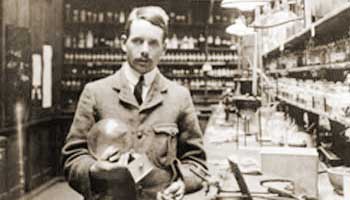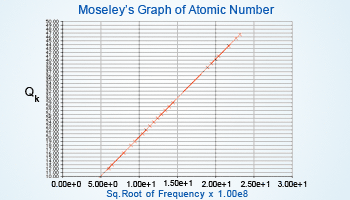 Moseley determined the number of positive charges in the nucleus by measuring the wavelength of
X–rays given off by certain metals in 1913. The wavelengths of the X–ray emissions of the elements coincided with
the ordering of the elements by atomic number. When isotopes were discovered, it was clear that atomic weight was not as
significant in periodic law, rather element properties varied with atomic number. When atoms were arranged by increasing atomic
number, the problems with Mendeleev's periodic table disappeared.
Moseley determined the number of positive charges in the nucleus by measuring the wavelength of
X–rays given off by certain metals in 1913. The wavelengths of the X–ray emissions of the elements coincided with
the ordering of the elements by atomic number. When isotopes were discovered, it was clear that atomic weight was not as
significant in periodic law, rather element properties varied with atomic number. When atoms were arranged by increasing atomic
number, the problems with Mendeleev's periodic table disappeared.
Soon after Rutherford's landmark experiment of discovering the proton in 1911, Henry Moseley (1887–1915) subjected known elements to x–rays. He was able to derive the relationship between x–ray frequency and number of protons. When Moseley arranged the elements according to increasing atomic numbers and not atomic masses, some of the inconsistencies associated with Mendeleev's table were eliminated. The modern periodic table is based on Moseley's Periodic Law (atomic numbers).
Moseley determined the number of positive charges in the nucleus by measuring the wavelength of X–rays given off by certain metals in 1913. The wavelengths of the X–ray emissions of the elements coincided with the ordering of the elements by atomic number. When isotopes were discovered, it was clear that atomic weight was not as significant in periodic law, rather element properties varied with atomic number. When atoms were arranged by increasing atomic number, the problems with Mendeleev's periodic table disappeared.
Moseley revised the periodic table and made a bold change that removed all inconsistencies. He suggested that instead of arranging elements in the ascending order of their atomic masses, they should be arranged in the ascending order of their atomic numbers. The number of electrons in an atom is equal to the atomic number Z. Thus by making this change, Moseley put the emphasis on electronic configuration of the elements. Also it must be remembered that all physical and chemical properties come about because of the arrangements of electrons.
 Moseley's problem was to find a linear relationship between the atomic number and a measureable
property of the nucleus. The atomic number increased by steps of one (18, 19, 20, 21, and so on). Moseley needed some function
of a nuclear property that increased in the same pattern, that is, by one for each element in turn. He found it in the K line
of the X–ray spectra of each element. It turns out that the square root of the frequency moves by a constant value for
each one unit move by the atomic number. The graph was linear, with the frequency square root value moving up the same amount
for each one unit jump in the atomic number.
Moseley's problem was to find a linear relationship between the atomic number and a measureable
property of the nucleus. The atomic number increased by steps of one (18, 19, 20, 21, and so on). Moseley needed some function
of a nuclear property that increased in the same pattern, that is, by one for each element in turn. He found it in the K line
of the X–ray spectra of each element. It turns out that the square root of the frequency moves by a constant value for
each one unit move by the atomic number. The graph was linear, with the frequency square root value moving up the same amount
for each one unit jump in the atomic number.
The modern statement of the periodic law is that the properties of the elements are the periodic function of their atomic numbers.
In the modern periodic table, atoms with similar electron configurations are placed in the same column. The columns are called as groups. Elements across in periods show integral increase in valence electrons. The adjacent figure shows how elements in Group I, the alkali elements, are arranged. All of them have single valence electron and display similar properties of chemical reactivity, formation of oxides, etc. The elements in period 3 are also shown. The elements in a period show increase in the last electronic configuration.
The modern periodic table is a very neat representation of all elements. The chart is easy to read and the arrangement is so accurate, that if you know properties of a few elements, you will be able to make a close guess of other elements close to them. The table also eliminated anomalies in Mendeleev's periodic table of elements.
 Modern Periodic Table
Modern Periodic Table
Features of periodic table:
- It consists of 7 horizontal periods. The lengths of the periods increase with the order of the period. Elements in a
period have consecutive atomic numbers.
- The 1st period is the shortest period. It consists of just two elements ‘H’ and ‘He’.
- The 2nd and the 3rd periods have 8 elements each and are called short periods.
- The 4th and the 5th periods are long periods and have 18 elements each.
- The 6th period has 32 elements. The period has a 15 element series called lanthanide series, separated from the table. The lanthanide series elements are rare–earth elements that show similar properties.
- The 7th period contains all the rest of the elements. It is incomplete. This period also has a 15 element series called the actinide series, separated from the table. The actinide series have a separate identity and contain uranium and most of the known transuranic elements.
- The vertical columns are called groups. There are 18 groups in the periodic table. Elements in a group do not have
consecutive atomic numbers.
- The groups are divided into A and B groups.
- Group IA to VIII A has all the normal elements.
- Group IB to VIII B holds all the transition metal elements.
- The other two groups are the lanthanide and the actinide series. They are also known as inner transition elements.
 Longform Periodic Table
Longform Periodic Table
- The modern periodic table is approximately divided into metals and non–metals. The most metallic elements such as alkali metals are on the left–hand side. The non–metals are on the right hand side. The inert gases or the noble gases with their completely filled electronic shells are placed on the extreme right hand side. The transition metals, which are a bridge between highly metallic alkali elements and the non–metals, lie in the center of the table. Lanthanide and actinide series (or the inner transition elements), which have metal like behavior, and are kept separately as their outermost electronic configurations, differ from the transition metal elements.